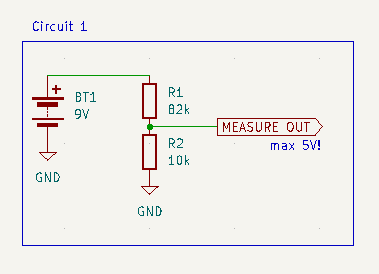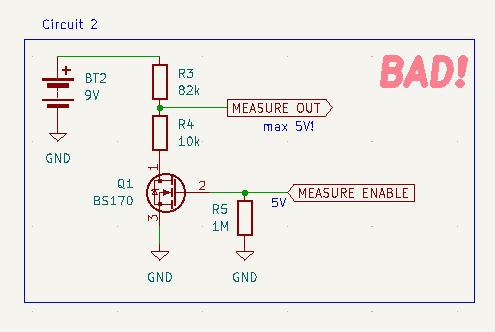I am powering a 5V microcontroller (arduino clone, atmega328p) using a 9V block and a buck converter. Now I want to let the microcontroller occasionally measure the battery voltage, so I can get an idea of how full it is.
My first idea was to use a simple voltage divider:

I’ve chosen the resistor values so that:
- the voltage at the measure output is
< 1.1V, to be able to use the 1.1V internal reference of the atmega’s ADC R1 || R2 < 10kΩ, since the atmega datasheet says “The ADC is optimized for analog signals with an output impedance of approximately 10 kΩ or less”
This is great and all, but what bothers me is that this circuit will constantly draw ~100µA from the battery.
So, my next thought was to add a mosfet to the divider, to switch it on only while measuring:

This is obviously bad, because now when the mosfet is off, the ADC input sees the whole battery voltage.
To address that issue, I’ve added a second mosfet into the measure path:

This works, and it does not draw any current, except while measuring.
However, it’s quite a few parts. So I’m curious if anyone has an idea how to do this with just a single mosfet. It seems to me like it should be possible, but I haven’t figured out how.
Oh, and if I’m doing something stupid here, please tell me :)


You could probably increase the 82K and 10K resistors to be much bigger (by a factor of 10x or maybe even 100x). Lookup the input impedance for the ADC of your model of ATmega, as long as it’s >10x the size of your resistors then your circuit will probably be accurate enough.
A couple more things to keep in mind:
That’s what I thought initially, but this stackoverflow post dissuaded me. The argument there is that the measurement will be wrong, if the input current is not enough to charge the internal cap within the measurement period. But I’ve done some testing now, and measurements done with 820k and 100k agree well with what my voltmeter measures, so I’ll go with this solution!
Indeed!
9.6V * 10k/92k = 1.04Vis still below 1.1V, so I should be fine in this case :)This is a good point!
My firmware will be pretty monotonic though, basically:
So, the load should be always the same at step (2).
@nilclass
@WaterWaiver
From the stack exchange post: " 10 kΩ or less source resistance is recommended, otherwise the low pass filter effect of the capacitor with the source resistance becomes a major issue, requiring a longer sampling time for conversion and as a result limiting the maximum frequency."
In other words: a higher source impedance (caused by large resistors) is only going to drastically affect the results when you need to take fast repeated measurements (e.g. an AC source)